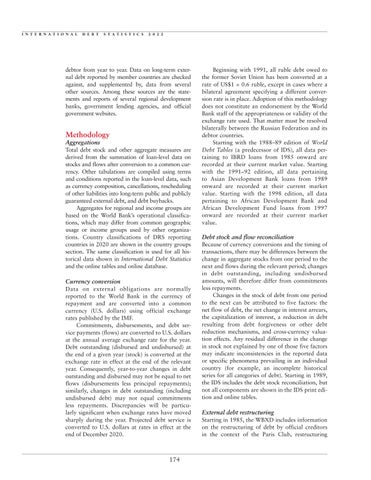I N T E R N A T I O N A L
D E B T
S T A T I S T I C S
2 0 2 2
debtor from year to year. Data on long-term external debt reported by member countries are checked against, and supplemented by, data from several other sources. Among these sources are the statements and reports of several regional development banks, government lending agencies, and official government websites.
Methodology Aggregations
Total debt stock and other aggregate measures are derived from the summation of loan-level data on stocks and flows after conversion to a common currency. Other tabulations are compiled using terms and conditions reported in the loan-level data, such as currency composition, cancellations, rescheduling of other liabilities into long-term public and publicly guaranteed external debt, and debt buybacks. Aggregates for regional and income groups are based on the World Bank’s operational classifications, which may differ from common geographic usage or income groups used by other organizations. Country classifications of DRS reporting countries in 2020 are shown in the country groups section. The same classification is used for all historical data shown in International Debt Statistics and the online tables and online database.
Currency conversion Data on external obligations are normally reported to the World Bank in the currency of repayment and are converted into a common currency (U.S. dollars) using official exchange rates published by the IMF. Commitments, disbursements, and debt service payments (flows) are converted to U.S. dollars at the annual average exchange rate for the year. Debt outstanding (disbursed and undisbursed) at the end of a given year (stock) is converted at the exchange rate in effect at the end of the relevant year. Consequently, year-to-year changes in debt outstanding and disbursed may not be equal to net flows (disbursements less principal repayments); similarly, changes in debt outstanding (including undisbursed debt) may not equal commitments less repayments. Discrepancies will be particularly significant when exchange rates have moved sharply during the year. Projected debt service is converted to U.S. dollars at rates in effect at the end of December 2020.
174
Beginning with 1991, all ruble debt owed to the former Soviet Union has been converted at a rate of US$1 = 0.6 ruble, except in cases where a bilateral agreement specifying a different conversion rate is in place. Adoption of this methodology does not constitute an endorsement by the World Bank staff of the appropriateness or validity of the exchange rate used. That matter must be resolved bilaterally between the Russian Federation and its debtor countries. Starting with the 1988–89 edition of World Debt Tables (a predecessor of IDS), all data pertaining to IBRD loans from 1985 onward are recorded at their current market value. Starting with the 1991–92 edition, all data pertaining to Asian Development Bank loans from 1989 onward are recorded at their current market value. Starting with the 1998 edition, all data pertaining to African Development Bank and African Development Fund loans from 1997 onward are recorded at their current market value.
Debt stock and flow reconciliation Because of currency conversions and the timing of transactions, there may be differences between the change in aggregate stocks from one period to the next and flows during the relevant period; changes in debt outstanding, including undisbursed amounts, will therefore differ from commitments less repayments. Changes in the stock of debt from one period to the next can be attributed to five factors: the net flow of debt, the net change in interest arrears, the capitalization of interest, a reduction in debt resulting from debt forgiveness or other debt reduction mechanisms, and cross-currency valuation effects. Any residual difference in the change in stock not explained by one of those five factors may indicate inconsistencies in the reported data or specific phenomena prevailing in an individual country (for example, an incomplete historical series for all categories of debt). Starting in 1989, the IDS includes the debt stock reconciliation, but not all components are shown in the IDS print edition and online tables.
External debt restructuring Starting in 1985, the WBXD includes information on the restructuring of debt by official creditors in the context of the Paris Club, restructuring

